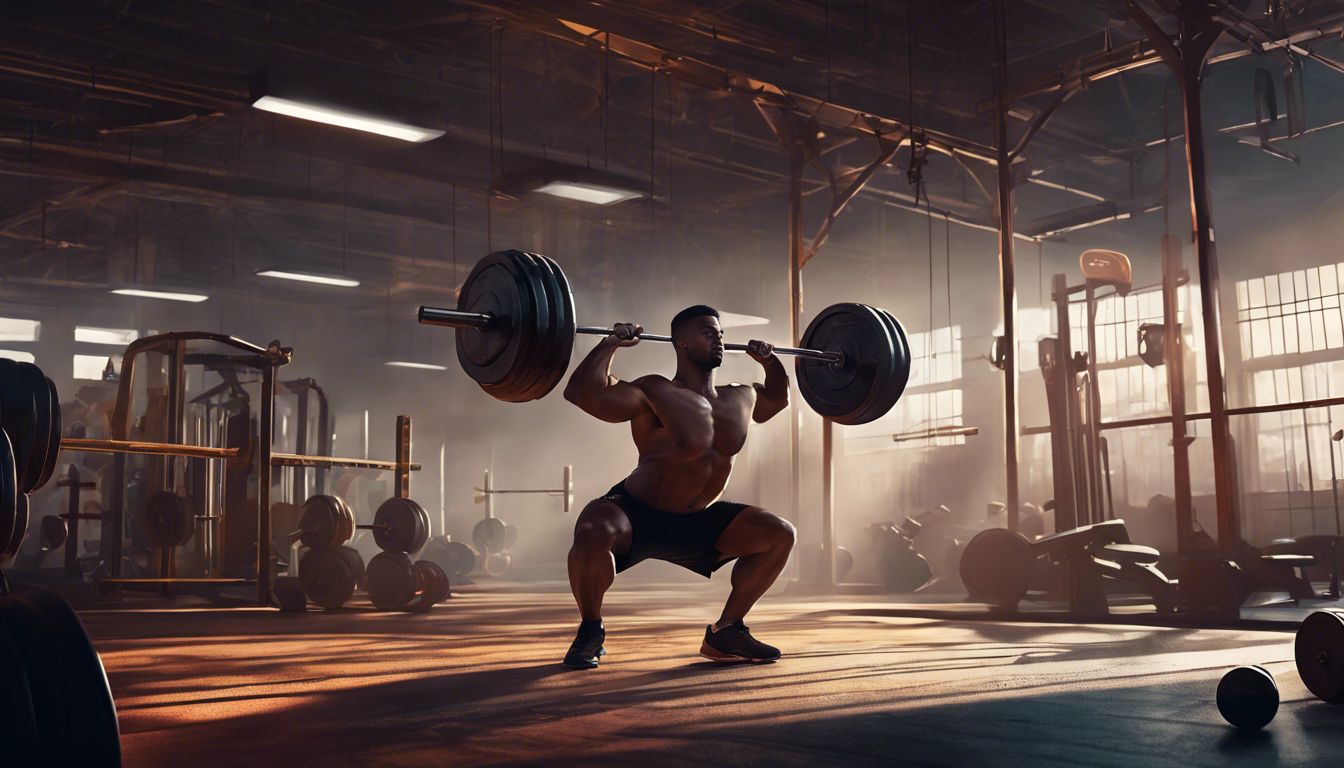Building bigger, stronger legs while sidestepping injuries is no simple feat. I know the struggle all too well but discovered that the secret sauce lies in lower body strength training.
This guide is your ticket to mastering essential leg workouts—from squats and lunges to deadlifts—complete with tips for keeping those pesky injuries at bay. So, lace up your sneakers; it’s leg day.
Key Takeaways
- To grow stronger legs, squats, deadlifts, and lunges are essential exercises. They work many muscles at once and help build muscle mass.
- Using the right form and technique in leg workouts is crucial to prevent injuries. It’s important to align your body correctly and increase weights or reps safely over time.
- Warming up before exercising and cooling down afterward are key steps to keep your muscles safe. These practices prepare your muscles for heavy lifting and help them recover after a workout.
- Adding variety to leg workouts, like High-Intensity Interval Training (HIIT) and plyometrics, can boost muscle growth. These activities make workouts more fun while increasing strength and power.
- Progressive overload helps muscles get stronger by gradually increasing the weight or reps. This approach keeps the workouts challenging and ensures continuous improvement in muscle size and strength.
Essential Leg Exercises for Muscle Growth
To get bigger legs, you need to do the right workouts. Squats, deadlifts, and lunges are key moves for muscle growth in your legs.
Squats
I do squats to make my legs and back stronger. Squats use many muscles like quadriceps, hamstrings, glutes, abdominals, and calves. This exercise is great for building muscle in the lower body and core.
Doing squats also helps me burn calories and improve my balance.
By regularly squatting, I take steps to prevent injuries. It strengthens leg and back muscles well. Having strong muscles can stop accidents before they happen. Plus, squats boost my core strength which makes me feel more balanced and confident in daily activities.
Deadlifts
Deadlifts are a powerhouse move for my leg days because they work so many muscles at once. They hit my lower back, glutes, hamstrings, and even the core. I find this exercise key for muscle growth in my legs.
It’s not just about the back; deadlifting also engages my quadriceps which are crucial for beefing up my leg muscles.
I pay close attention to form while performing deadlifts. This ensures I’m targeting the right areas—my legs, back, and posterior chain effectively. Using barbells or kettlebells helps me maintain this form and maximize muscle engagement.
Deadlift variations like the Romanian deadlift add spice to my routine while focusing on strengthening those essential erector spinae and quad muscles.
Lunges
Moving from deadlifts to lunges, I shift my focus on enhancing the lower part of my body. Lunges are key for getting strong and shaped legs. These exercises work wonders for muscles in the legs, back, and belly area.
They fit well for anyone, no matter their fitness journey stage. Plus, lunges fix muscle imbalances.
I make sure to include different types of lunges in my routine—like reverse lunges, walking lunges, and Bulgarian split squats. These variations keep me balanced and build core strength.
By doing them regularly, I boost the power in my hips and knees which also betters the quality of my leg muscles overall. Lunges target my quads, hamstrings, glutes, and calf muscles all at once! This not only steps up lower body strength but sharpens balance and stability too.
Techniques to Maximize Leg Day Results

To get the most out of leg day, add more weight or reps over time. This method, called progressive overload, makes muscles stronger. Always use the right moves to avoid getting hurt and see better growth in your legs.
Progressive Overload
Progressive overload means I make my workouts harder over time. This helps my muscles get stronger and healthier. For example, if I’m doing back squats one week with a certain weight, the next week I might add more weight or do more reps.
This method works for running, lifting, and many other exercises too. It keeps my body from getting used to the same old thing so I can keep building muscle.
Proper form is key in every exercise, from goblet squats to deadlifts. Learning how to increase the challenge safely is what makes progressive overload so effective in boosting my health and fitness levels.
Next up: why focusing on proper form and technique matters just as much.
Proper Form and Technique
I always make sure to focus on my form and technique during leg workouts. Good form means aligning my body correctly and moving smoothly through each exercise. This helps me prevent injury and get the most out of my workout.
For example, when doing squats, I keep my feet shoulder-width apart and my back straight. I lower myself as if sitting in a chair, keeping my knees behind my toes. This way, I target the right muscles in my thighs and butt without hurting myself.
Using one leg at a time can also help me stay balanced. Exercises like single-leg squats or lunges allow me to work on each leg separately. This prevents one side from becoming stronger than the other, an issue called a muscular imbalance that could lead to injuries down the road.
Also, speaking with a personal trainer helped me understand how important flexibility is for injury prevention during these exercises. They showed me proper warm-up moves that prep my legs by increasing blood flow and stretching out key muscles near the pelvis area before going into heavier lifts like deadlifts or barbell squats.
Preventing Injuries During Leg Workouts
To keep safe during leg exercises, starting with a warm-up is key. It gets your blood flowing and muscles ready for action. Next, don’t forget to cool down after your workout. This helps your body slowly relax and can stop muscle pain.
Warm-Up Routines
I always start my leg workouts with a warm-up. This gets my blood flowing and preps my muscles for the heavy lifting ahead. Here’s what I include in my routine:
- I begin with jumping jacks to wake up my body. This simple move increases my heart rate and gets blood pumping to all parts of my body.
- Next, I do high knees and butt kicks to target the lower body specifically. These exercises help me focus on my legs, warming them up for more intense movements.
- I add front squats with no weights to practice form. Doing this helps me prepare for heavier squats later, ensuring I don’t hurt myself.
- Lunges come next, both forward and sideways variations, to stretch and strengthen my upper and lower legs while also engaging my core.
- To avoid injuries like those common in female youth football players, I incorporate a mix of isometric exercises that enhance hamstring flexibility. These include moves such as standing calf raises which challenge balance too.
- Hamstring curls using free weights get added into the mix for concentric and eccentric muscle actions, aiding in preventing hamstring injuries.
- Lastly, calf raises round out my warm-up by focusing on the lower leg muscles – from the shin bone down to the heel bone – preparing them for heavier exercises like deadlifts and hack squats.
This comprehensive warm-up ensures not only better performance during the workout but significantly reduces the risk of injuries, setting a solid foundation for muscle growth and strength gains in my legs.
Cool-Down Practices
Cooling down after a leg workout is just as important as the workout itself. It helps lower my risk of injury and reduces muscle soreness. Here’s how I make sure my legs recover properly:
- Start with light cardio: After lifting heavy or pushing my limits, I switch to a low-intensity activity like walking or cycling for five minutes. This helps get rid of the lactic acid that builds up in my muscles.
- Stretch the major leg muscles: I focus on stretching my calves, hamstrings, and quadriceps. Holding each stretch for at least 30 seconds helps increase my flexibility and prevents tightness.
- Do seated calf raises: These target the soleus muscle in the lower part of my legs. I make sure to do them slowly to cool down properly.
- Perform a hip flexor stretch: Since this area can tighten up after exercises like squats and lunges, I pay special attention to stretching it out by doing lunges with a twist towards the extended leg.
- Incorporate yoga poses: Moves like downward dog and pigeon pose are great for targeting the whole leg, including areas like the gastrocnemius and Achilles’ tendon, providing a deep stretch.
- Finish with foam rolling: I use this tool to roll out all sections of my upper legs – quads, hamstrings, and even glutes to help in breaking down knots and promoting blood flow.
- Practice deep breathing: While cooling down, I also take deep breaths to help reduce cortisol levels in my body which spike during intense physical activity.
This routine not only aids in preventing injuries but also prepares me for future workouts by keeping muscle imbalances at bay and ensuring optimal recovery.
Incorporating Variety for Optimal Leg Development
To grow strong legs, it’s key to mix up your workouts. Adding fast-paced drills and explosive movements will really shape your lower body.
High-Intensity Interval Training (HIIT)
I love adding High-Intensity Interval Training (HIIT) to my leg workouts because it’s fun and really effective. HIIT combines short bursts of very active exercises like jump squats and lunges with periods of rest or lower-intensity activities.
This mix helps me get the most out of my workout time. Studies show that people enjoy HIIT more than just jogging at a steady pace because it’s less boring and feels more rewarding.
HIIT also boosts health in ways similar to traditional exercises but takes less time. It burns calories fast, which helps decrease body fat. Plus, doing HIIT can make your heart stronger and reduce risks for diseases like diabetes and heart disease.
I’ve noticed my legs becoming stronger and bigger from these workouts, thanks to how HIIT targets both aerobic stamina and muscle strength in one go.
Plyometrics
After pushing myself with High-Intensity Interval Training, I turn to plyometrics for my legs. These jump exercises build speed, power, and strength. They make me quick and help avoid injuries like noncontact ACL ones.
This kind of training is crucial for anyone wanting to boost their leg muscle growth or improve sports performance. It’s a key way to teach our bodies how to land safely and develop explosive force.
Using plyometric drills bridges the gap between pure muscle building and athletic prowess. Jumping routines such as squat jumps and box drills not only condition skeletal muscles but also strengthen knee joints, hip extensors, and butt muscles.
These activities are gold for reducing injury risks while cranking up my running speed and agility on the field or court. And by blending strength training with these dynamic moves, I’m tackling muscular imbalances head-on – decreasing chances for issues like osteoporosis or fractures down the road.
Conclusion
I learned a lot about how to get bigger legs and keep them safe. I found out that doing squats, deadlifts, and lunges are key. Making sure my form is right and adding more weight slowly helps me see better results.
It’s also super important to warm up before and cool down after to avoid getting hurt. Plus, mixing in different workouts like high jumps keeps things fun and works my muscles in new ways.
This journey showed me how strong legs are not just for looks but also for a healthier life with fewer injuries.
FAQs
1. How do I get bigger legs?
To get bigger legs, I focus on muscle-building exercises like squats, leg presses, and Bulgarian split-squats. These compound exercises work multiple muscles at once, helping me grow stronger.
2. Can exercise help if I have arthritis or obesity?
Yes! Working out can reduce pain from arthritis and help manage obesity. Exercises like pushing up on my tiptoes or doing gentle squats support my joints and improve strength without causing injury.
3. What exercises should I avoid to prevent hurting my knees?
I stay away from high-impact moves that strain my knee extensors and pelvic area too much. Instead of jumping into deep squat positions or heavy bench pressing right away, I build up gradually with safer alternatives.
4. How can I avoid getting tired during my leg workout?
To keep from getting too tired, I break up my routine into sections focusing on different muscles each time—like doing extensions for one part of the workout and sumo squats in another section.
5. What’s a good way to start working out if I’m new to leg workouts?
If you’re just starting, try simpler exercises like pistol squats or push-ups against a wall to build strength slowly over time. An exercise physiologist can also suggest personalized routines that match your level of fitness without risking injury.




Leave a Reply